Škoda Fabia
| Škoda Fabia | |
|---|---|
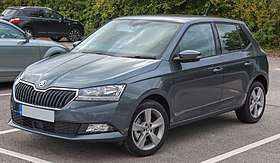 | |
| Overview | |
| Manufacturer | Škoda Auto |
| Production | 1999–present |
| Body and chassis | |
| Class | Supermini |
| Chronology | |
| Predecessor | Škoda Felicia |
The Škoda Fabia is a supermini car produced by Czech manufacturer Škoda Auto since 1999. It is the successor of the Škoda Felicia, which was discontinued in 2001. The Fabia was available in hatchback, estate (named Fabia Combi) and saloon (named Fabia Sedan) body styles at launch, and since 2007, the second generation is offered in hatchback and estate versions. The third generation Fabia was launched in 2015.
First generation (Typ 6Y; 1999–2007)
| Škoda Fabia Mk1 (6Y) | |
|---|---|
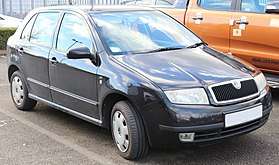 | |
| Overview | |
| Production | 1999–2007 |
| Assembly |
Mladá Boleslav, Czech Republic Nairobi, Kenya (CMC) Solomonovo, Ukraine (Eurocar) Kaluga, Russia |
| Body and chassis | |
| Body style |
4-door saloon 5-door hatchback 5-door estate |
| Platform | Volkswagen Group A04 (PQ24) |
| Related |
SEAT Ibiza Mk3 SEAT Córdoba Mk2 Volkswagen Polo Mk4 |
| Powertrain | |
| Engine |
1.0 L I4 MPI (petrol) 1.2 L I3 HTP (petrol) 1.4 L I4 MPI (petrol) 1.4 L I4 16V (petrol) 2.0 L I4 MPI (petrol) 1.4 L I3 TDI (diesel) 1.9 L I4 SDI (diesel) 1.9 L I4 TDI (diesel) |
| Transmission |
5-speed manual 6-speed manual (RS only) 4-speed automatic |
| Dimensions | |
| Wheelbase | 2,460 mm (96.9 in) |
| Length |
3,960 mm (155.9 in) (hatchback) 4,220 mm (166.1 in) (saloon/estate) |
| Width | 1,650 mm (65.0 in) |
| Height | 1,450 mm (57.1 in) |
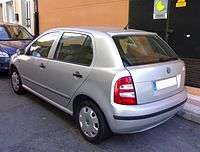
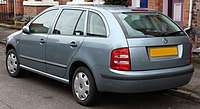
The first generation Fabia (given the internal type code 6Y) was officially presented at the Frankfurt Motor Show in September 1999 and production of this model started in October the same year. The estate version Fabia Combi was introduced in September 2000 at the Paris Motor Show. It was the first model to use the Volkswagen Group's A04 platform, which it shared with the Volkswagen Polo Mk4 and SEAT Ibiza. In the United Kingdom, for 2000, this car won What Car?'s "Car of the Year". The range started with the 1.0 8v Classic (which was cheaper than Volkswagen's smaller 3-door 1.0 Lupo when on sale) to the 1.9 PD TDi VRS.
Part of the Fabia's success was the fact that all of its mechanical parts were developed by or in conjunction with Volkswagen, but were offered in a package that is priced to undercut other models in the Volkswagen Group. The only traces of non-VW Škoda left in the Fabia are the 1.0 and 1.4 8v "MPI" engines, which were modifications to Škoda's own 1.3 engine, and were used in pre-Volkswagen Škodas such as the Estelle and Favorit.
.jpg)
%2C_Bj._2007_(2009-04-13)_r.jpg)
_%E2%80%93_Heckansicht%2C_15._Juni_2011%2C_W%C3%BClfrath.jpg)
.jpg)
In 2004 the Fabia received a facelift, with changed front fog lights and grille, slightly different rear lights, new steering wheel and revised specification levels. The VRS also had its final gearbox ratio changed. Most importantly, the Sport model was added, with the 75 PS (55 kW) 1.4 petrol being offered with a manual transmission. This engine was quickly dropped for the 1.2 HTP, which while not as powerful, was a much more free revving engine giving a more sporty feel and flexible drive. The Sport also had its specification changed to include red seat belts and sunset privacy glass from the B pillar to the rear.
Again in 2006 the Fabia range shown at the Geneva Motor Show had minor specification revisions. These include a center rear head rest, a central three-point seatbelt and an additional four bodywork colours. The 1.4 16v 75 PS (55 kW) petrol engine was replaced with a more powerful 1.4 16v 80 PS (59 kW) engine.
Engines
The term MPI (Multi-Point Injection) is used by Škoda to differentiate from 16v models and (in the case of the Octavia Mk2) FSI engines. The 75 PS (55 kW) version of the 1.4 16v was only mated to Volkswagen's four-speed automatic transmission with fuzzy logic operation until the addition of earlier Sport models which mated it with a manual transmission. The 1.4 8v was dropped in 2003. The Fabia's overall performance and fuel consumption figures fall behind other city cars and small family cars as it is larger and heavier. However, the 1.2 HTP (High Torque Performance) engine was developed specifically for the Fabia and offers better performance and fuel economy, and was later used in Volkswagen's own Polo due to its high acclaim. It was also the highest displacement 3 cylinder petrol engine until 2014 and BMW's 1.5 litre 3 cylinder turbo engine.
| Model | Years | Engine and code | Displ. | Power | Torque | |
|---|---|---|---|---|---|---|
| 1.0 8V | 1999–2000 | I4 | AQV/ATY/ARV | 997 cc | 37 kW (50 PS; 50 hp) at 5000 rpm | 84 N⋅m (62 lb⋅ft) at 2750 rpm |
| 1.2 MPI 6V | 2001–2003 | I3 | AWY/BMD | 1198 cc | 40 kW (54 PS; 54 hp) at 4750 rpm | 108 N⋅m (80 lb⋅ft) at 3000 rpm |
| 1.2 HTP 6V | 2003–2007 | I3 | AWY/BMD | 1198 cc | 40 kW (54 PS; 54 hp) at 4750 rpm | 108 N⋅m (80 lb⋅ft) at 3000 rpm |
| 1.2 HTP 12V | 2003–2007 | I3 | AZQ/BME | 1198 cc | 47 kW (64 PS; 63 hp) at 5400 rpm | 112 N⋅m (83 lb⋅ft) at 3000 rpm |
| 1.4 MPI | 2000–2003 | I4 | AZE/AZF | 1397 cc | 44 kW (60 PS; 59 hp) at 5000 rpm | 118 N⋅m (87 lb⋅ft) at 2600 rpm |
| 1.4 MPI | 1999–2003 | I4 | AME/AQW/ATZ | 1397 cc | 50 kW (68 PS; 67 hp) at 5000 rpm | 120 N⋅m (89 lb⋅ft) at 2500 rpm |
| 1.4 16V | 2000–2007 | I4 | APE/AUA/BBY/BKY | 1390 cc | 55 kW (75 PS; 74 hp) at 5000 rpm | 126 N⋅m (93 lb⋅ft) at 3800 rpm |
| 1.4 16V | 2006–2007 | I4 | BUD | 1390 cc | 59 kW (80 PS; 79 hp) at 5000 rpm | 132 N⋅m (97 lb⋅ft) at 3800 rpm |
| 1.4 16V | 1999–2007 | I4 | AUB/BBZ | 1390 cc | 74 kW (101 PS; 99 hp) at 6000 rpm | 126 N⋅m (93 lb⋅ft) at 4400 rpm |
| 2.0 8V | 1999–2000 | I4 | ATF | 1984 cc | 88 kW (120 PS; 118 hp) at 5600 rpm | 174 N⋅m (128 lb⋅ft) at 2400 rpm |
| 2.0 8V | 2000–2007 | I4 | AZL/BBX | 1984 cc | 85 kW (116 PS; 114 hp) at 5200 rpm | 170 N⋅m (130 lb⋅ft) at 2400 rpm |
| 1.4 TDI 6V | 2005–2007 | I3 | BNM | 1422 cc | 51 kW (69 PS; 68 hp) at 4000 rpm | 155 N⋅m (114 lb⋅ft) at 1600–2800 rpm |
| 1.4 TDI 6V | 2003–2005 | I3 | AMF | 1422 cc | 55 kW (75 PS; 74 hp) at 4000 rpm | 195 N⋅m (144 lb⋅ft) at 2200 rpm |
| 1.4 TDI 6V | 2005–2008 | I3 | BNV | 1422 cc | 59 kW (80 PS; 79 hp) at 4000 rpm | 195 N⋅m (144 lb⋅ft) at 2200 rpm |
| 1.9 SDI 8V | 1999–2006 | I4 | ASY | 1896 cc | 47 kW (64 PS; 63 hp) at 4000 rpm | 125 N⋅m (92 lb⋅ft) at 1600–2800 rpm |
| 1.9 TDI PD 8V | 2000–2007 | I4 | ATD/AXR | 1896 cc | 74 kW (101 PS; 99 hp) at 4000 rpm | 240 N⋅m (180 lb⋅ft) at 1800–2400 rpm |
| 1.9 TDI PD 8V VRS | 2003–2007 | I4 | ASZ/BLT | 1896 cc | 96 kW (131 PS; 129 hp) at 4000 rpm | 310 N⋅m (230 lb⋅ft) at 1900 rpm |
Trim levels
At launch, the Fabia was available in three trim levels: Classic, Comfort, and Elegance. Later in the Fabia's life the mid-range Comfort model was dropped for the name Ambiente to fit in with the rest of the range. Other models available throughout the car's lifespan included Ambiente SE, Blackline, Silverline, Sport, Bohemia (estate only, run-out model) and VRS. Various safety features and minor changes were made over time. Easy and Junior models were sold in Eastern European markets where the buying power is lower. Some of these Fabias do not have painted bumpers, side mirrors or gloveboxes. The Junior didn't have power steering and the steering wheel was 'borrowed' from Octavia I. Because of that, it was slightly bigger, with a diameter of 380 mm instead of the regular 370 mm found on all the other Fabia models. Also sold in such markets is the Fabia Praktik, which is a panel van version of the Fabia with the rear windows and seats removed. A lesser powered version of the 1.4 MPI with just 60 PS (44 kW) is also sold in Eastern Europe. The downfall of this weaker engine was that it struggled to shift the weighty car. Unless on flat surfaces it struggled to achieve higher than 30MPG.
Fabia VRS
Introduced in 2003, the Fabia VRS, while not the first diesel hot hatch, was the first exclusively diesel hot hatch, having no petrol equivalent. The engine is Volkswagen Group's 1.9 litre Pumpe-Düse Turbocharged Direct Injection diesel engine, producing 130 metric horsepower (96 kW) and 310 N⋅m (230 lb⋅ft) at 1900 rpm, with a six-speed manual gearbox. It was named the "Diesel Car of the Year 2003" in the Scottish Car of the Year Awards. It also falls in a low tax band (Band C) in the UK, further increasing its cost benefits over its (chiefly petrol-powered) counterparts (although this is disputed, as most VRS' are tax band F, costing £145 a year as of 2017).
Official figures state 0 to 100 km/h (62 mph) takes 9.6 seconds, but several motoring magazines and websites have measured faster times (around the 7.0–7.5 seconds range) (Autocar: 7.1 seconds,[1] Auto Express: 8.1 seconds,[2] and FastHatchbacks.com: 8.5 seconds[3]). The in gear acceleration times are 50–70 mph in 5.6 seconds, quicker than BMW's 330i which takes 6.0 seconds. 20–40 mph in 2.4 seconds is as quick as the Lotus Elise 111R. Despite this the Fabia VRS can achieve better than 6.2 L/100 km (46 mpg‑imp; 38 mpg‑US). The Fabia VRS has a top speed of 128 mph (206 km/h).
The VRS was shown to be quicker than a similarly priced MINI Cooper around Top Gear's and Fifth Gear's test tracks.
In 2007 1,000 Special Edition Fabia VRS models were produced[4] featuring individually numbered black leather seats with blue piping, sporty red brake callipers, "Race Blue" metallic paint, cruise control, darkened rear windows and a six CD autochanger. This model was known as the Fabia VRS SE.
The last Mk1 Fabia VRS came off the production line in March 2007 – being UK 2007/07 registered. There is also a 2009 version, which is believed to be a late registration.
According to Škoda UK, there were only 22 of these 2007 registered marks (not including the 1000 Special Edition VRS SEs).
Second generation (Typ 5J; 2007–2014)
| Škoda Fabia Mk2 (5J) | |
|---|---|
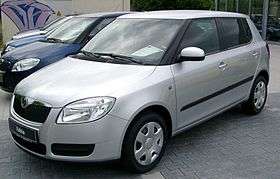 | |
| Overview | |
| Also called |
Škoda Fabia Jingrui (China) Škoda Fabia 5J (Ukraine, until 4/2010) Škoda Fabia MG (Ukraine, since 4/2010) |
| Production | 2007–2014 |
| Assembly |
Mladá Boleslav, Czech Republic Aurangabad, India (Škoda India, until 31 August 2013)[5] Oskemen, Kazakhstan (Azia Avto) Anting, China (SVW) Solomonovo, Ukraine (Eurocar) |
| Body and chassis | |
| Body style |
5-door hatchback 5-door estate |
| Layout | Front-engine, front-wheel-drive |
| Platform | Volkswagen Group A04 (PQ24) platform |
| Related |
Škoda Rapid (India) Škoda Roomster SEAT Ibiza Mk3 SEAT Córdoba Mk2 Volkswagen Polo Mk4 |
| Powertrain | |
| Engine |
1.2 L I3 HTP (petrol) 1.2 L I4 TSI (petrol) 1.4 L I4 16V (petrol) 1.4 L I4 TSI (petrol, vRS only) 1.6 L I4 16V (petrol) 1.2 L I3 TDI CR (diesel) 1.4 L I3 TDI PD (diesel) 1.6 L I4 TDI CR (diesel) 1.9 L I4 TDI PD (diesel) |
| Transmission |
5-speed manual 6-speed manual 6-speed automatic 7-speed automatic DSG |
| Dimensions | |
| Wheelbase | 2,460 mm (96.9 in) |
| Length |
4,000 mm (157.5 in) (hatchback) 4,247 mm (167.2 in) (estate) |
| Width | 1,642 mm (64.6 in) |
| Height | 1,498 mm (59.0 in) |

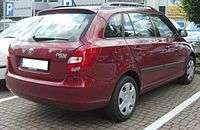
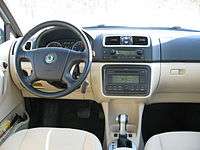
The second generation Fabia (internal type code 5J) was officially presented at the Geneva Auto Show in March 2007[6] and was sold from April 2007. It still uses the PQ24 platform.[7][8][9] The car is however slightly larger than its predecessor and takes styling cues from the Roomster, Škoda's small MPV.[10] The exterior of the two cars, Roomster and Fabia, were designed simultaneously to create synergies by Thomas Ingenlath and Peter Wouda.
The estate variant[11][12] was officially announced[13] in August 2007 and was introduced at the Frankfurt Motor Show in September 2007.[14] Compared with the first generation the new Combi is 7 mm (0.3 in) longer, 46 mm (1.8 in) higher and the boot has grown by 54 litres (to 480 litres total). The engine portfolio is the same as the hatchback version, without the 1.2 44 kW one.
The initial petrol engine line-up was a mixture of newer engines from Audi and some carry-overs from the outgoing model. In comparison to the 1st-generation Fabia, both basic 1.2-litre 3-cylinders gained 4 kW each: new power peak was 44 kW (60 PS), and 51 kW (70 PS). There was only a single 1.4-litre 16v petrol on this model, producing 63 kW (86 PS). The range-topping petrol engine was the 1.6-litre 4-cylinder with variable valve timing producing 77 kW (105 PS) . There was also an option to mate this engine with a 6-speed tiptronic transmission sourced from Aisin.
The diesel range featured the same 51 kW (70 PS) and 59 kW (80 PS) 1.4-litre Pumpe-Düse 3-cylinders from the predecessor model. The top-of-the-range diesel was a 1.9-litre Pumpe-Düse 4-cylinder producing 77 kW (105 PS).
The second generation Fabia trim levels were Classic, Ambiente, Sport and Elegance. In the UK the trim levels were called 1, 2, Sport, 3, and GreenLine (later S, SE, Elegance, and GreenLine). In India, the trim levels were Active, Classic, Ambiente and Elegance. All models sold within the EU were equipped with ABS, front passenger, driver and side airbags. Curtain airbags and ESC were available as an option.
Though the sedan body, and the VRS version were discontinued (the latter until facelift in 2010), the 2nd-generation Fabia offered variety of new choices. The GreenLine model was the most environmentally-friendly Fabia, with 59 kW 1.4-litre diesel 3-cylinder consuming 4.1 l/100 km, which is 109 g of CO2 per km. At the Frankfurt International Motor Show (IAA) 2007 Škoda presented near-production-state design study of the Fabia Scout: a rugged version of the Fabia Combi. However, it was until May 2009 when this car finally started to roll off the production line in Mladá Boleslav. The new-generation Fabia featured a specific design element: a roof in different colour than the rest of the body was available as an option.
Facelift
_77TSI_Monte_Carlo_hatchback_(2015-11-11)_01.jpg)
_77TSI_hatchback_(2015-07-15)_02.jpg)
_%E2%80%93_Heckansicht%2C_20._Februar_2011%2C_W%C3%BClfrath.jpg)
_%E2%80%93_Frontansicht%2C_2._April_2011%2C_D%C3%BCsseldorf.jpg)
The facelifted Fabia and Fabia Combi were premiered at the 2010 Geneva Motor Show. The updated version can be easily distinguished from prior versions by the different shape of the front bumper and front fog lights. Inside, new steering wheels were a noticeable difference. Though their shape remained the same, headlights with a projector module underwent technical changes: for full beam, a separate reflector is fitted on the inner side of the lamp, while the projector module (providing a dimmed beam) is on the outer side.
The engine line-up was updated along with a facelift, too. 1.2-litre TSI turbocharged petrol engines came as a replacement of the previous 1.4 and 1.6-litre MPI engines, providing significant improvements to fuel consumption and corresponding reductions in CO2 emissions. The Aisin automatic transmission previously used was also replaced with the 7-speed DSG dual-clutch gearbox (optional on 77 kW (105 PS; 103 hp) 1.2 TSI models), providing a reduction of over 30% in CO2 emissions for the 77 kW (105 PS; 103 hp) automatic derivative (compared to the previous 1.6-litre).[15] Diesel engines were updated to the common rail system and four-valve technology.
With the facelift a sports VRS version returned to the range, now available as both hatchback and estate. This model features the same 1.4-litre twin-charged petrol engine as the Volkswagen Polo Mk5 GTI, producing 132 kW (180 PS) and is mated with a 7-speed DSG dual-clutch transmission as standard. With top speed 226 km/h (Fabia Combi VRS), this is the fastest production Fabia ever. The VRS had its own version of the cake advertisement – ‚Mean Green‘, with a darker rock version of "My Favorite Things".
The GreenLine model received new technology, as well. Manufacturer's combined consumption for the Fabia GreenLine with brand-new 55 kW 1.2-litre 3-cylinder diesel engine is 3.4 l/100 km, which is 88 g CO2 per km. Gerhard Plattner, Austrian economy driver, managed to reach 2,006 km on a single tank of fuel, that is 2.21 l/100 km (127.8 mpg imp / 106.4 mpg US).
New to the lot was Monte Carlo version for both Fabia and Fabia Combi, using design features if the Škoda Fabia Sports Design Concept presented at 2009 Geneva Motor Show.
At the 30th Wörthersee GTI Treffen, Škoda revealed Fabia VRS 2000 design study based on Super 2000 rally car.
4 May 2012 Škoda produced 3-millionth Fabia. The number included 1,788,063 1st-generation cars, and another 1,211,937 2nd-generation Fabias.
Marketing
United Kingdom
For the launch of the new Fabia, Škoda UK commissioned an advertising campaign called Cake, featuring the making of a Fabia car out of cake which swapped rivets for raisins, metal for marzipan and spark plugs for sugar.[16]
China
Shanghai Volkswagen Automotive introduced the new Fabia to the public at the 2008 Guangzhou Motor Show. It was launched in China for the 2009 model year.
India
Škoda India launched the latest version of Fabia in 2008. The car was well praised by Indian motor magazines, but it couldn't live up to the hype created by the previous generation Octavia. Fabia has not succeeded in this market due to dealer problems, steep prices and Škoda trying to position itself as a luxury marque. Škoda India has decided to bring in more powerful engines at better prices and taken strict measures to improve dealer quality levels and curb excessive service costs.
Safety
Engines
The initial petrol engine lineup was a mixture of newer engines from Audi and some carry overs from the outgoing model. The base 1.2 remains the same (44 kW) while the higher powered version has its power output upped to 70 PS (51 kW). There was only a single 1.4 litre 16v petrol on this model, producing 85 PS (63 kW). The range topping petrol engine was the 1.6 16v engine producing 105 PS (77 kW) . There was also an option to link this engine to a six speed tiptronic transmission sourced from Aisin.
Diesel engines consisted of the same 70 PS (51 kW) and 80 PS (59 kW) 1.4 TDI units from before. The range topping diesel was a 1.9 TDI producing 105 PS (77 kW).
The top-of-the-line VRS model features the same 1.4 litre engine as the Volkswagen Polo Mk5 GTI, producing 180 PS (132 kW) and is fitted with a seven-speed DSG semi automatic transmission as standard. The VRS had its own version of the cake advertisement, with a darker rock version of "My Favorite Things".
Overview of engines available for the 2nd-generation Fabia (A05, Type 5J), incl. facelifted model.
| Engine designation | Production | Engine code (family) | Displacement, configuration, valvetrain, fuel system, aspiration | Motive power at rpm | max. torque at rpm | Gearbox (type), drive | Top speed [km/h] | 0–100 km/h [s] (0–62 mph) | Combined consumption [l/100 km / mpg imp / mpg US] | CO2 [g/km] |
|---|---|---|---|---|---|---|---|---|---|---|
| 1.2 MPI 44 kW | 2006–2010 | (EA111) | 1198 ccm, I3, 6V, OHC, MPI, naturally aspirated | 44 kW (60 PS; 59 hp) at 5200 rpm | 108 Nm. (80 lb•ft) at 3000 rpmm | 5-speed manual (MQ200), FWD | 155 | 16.5 | 5.9 / 47.9 / 39.9 | 140 |
| 1.2 MPI 44 kW | 2010–2014 | (EA111) | 1198 ccm, I3, 12V, DOHC, MPI, naturally aspirated | 44 kW (60 PS; 59 hp) at 5200 rpm | 108 Nm. (80 lb•ft) at 3000 rpm | 5-speed manual (MQ200), FWD | 155 | 16.5 | 5.5 / 51.4 / 42.8 | 128 |
| 1.2 MPI 51 kW | 2007–2014 | BZG (EA111) | 1198 ccm, I3, 12V, OHC, MPI, naturally aspirated | 51 kW (70 PS; 68 hp)at 5400 rpm | 112 Nm. (83 lb•ft) at 3000 | 5-speed manual (MQ200), FWD | 163 | 14.9 | 5.5 / 51.4 / 42.8 | 128 |
| 1.2 TSI 63 kW | 2010–2014 | CBZA (EA111) | 1197 ccm, I4, 8V, OHC, TSI, turbocharged | 63 kW(86 PS; 85 hp) at 4800 rpm | 160 Nm. (118 lb•ft) at 1500–3500 rpm | 5-speed manual (MQ200), FWD | 177 | 11.7 | 5.2 / 54.3 / 45.2 | 121 |
| 1.2 TSI 77 kW | 2010–2014 | CBZB (EA111) | 1197 ccm, I4, 8V, OHC, TSI, turbocharged | 77 kW (105 PS; 103 hp) at 5000 rpm | 175 Nm. (129 lb•ft) at 1500–4100 | 5-speed manual (MQ200), FWD | 191 | 10.1 | 5.3 / 53.3 / 44.4 | 124 |
| 1.2 TSI 77 kW | 2010–2014 | CBZB (EA111) | 1197 ccm, I4, 8V, OHC, TSI, turbocharged | 77 kW (105 PS; 103 hp) at 5000 rpm | 175 Nm. (129 lb•ft) at 1500–4100 | 7-speed automatic (DQ200), FWD | 189 | 10.2 | 5.3 / 53.3 / 44.4 | 124 |
| 1.4 MPI 63 kW | 2007–2014 | (EA111) | 1390 ccm, I4, 16V, DOHC, MPI, naturally aspirated | 63 kW (86 PS; 85 hp) at 5000 rpm | 132 Nm. (97 lb•ft) at 3800 rpm | 5-speed manual (MQ200), FWD | 175 | 12.2 | 5.9 / 47.9 / 39.9 | 139 |
| 1.4 MPI 63 kW (China) | 2008– | (EA111) | 1390 ccm, I4, 16V, DOHC, MPI, naturally aspirated | 63 kW (86 PS; 85 hp) at 5000 rpm | 132 Nm. (97 lb•ft) at 3750 rpm | 5-speed manual, FWD | 175 | 12.5 | 6.4 / 44.1 / 36.7 | N/A |
| 1.4 MPI 63 kW (China) | 2008– | (EA390) | 1390 ccm, I4, 16V, DOHC, MPI, naturally aspirated | 63 kW (86 PS; 85 hp) at 5000 rpm | 132 Nm. (97 lb•ft) at 3750 rpm | 6-speed automatic, FWD | 167 | 15.0 | 6.8 / 41.5 / 34.6 | N/A |
| 1.4 TSI 132 kW (VRS) | 2010–2014 | CAVE (EA111) | 1390 ccm, I4, 16V, DOHC, TSI, twincharged | 132 kW (180 PS;176 hp ) at 6200 rpm | 250 Nm. (184 lb•ft) at 2000–4500 rpm | 7-speed automatic (DQ200), FWD | 224 | 7.3 | 6.2 / 45.6 / 37.9 | 148 |
| 1.6 MPI 77 kW | 2007–2014 | (EA111) | 1598 ccm, I4, 16V, DOHC, MPI, naturally aspirated | 77 kW (105 PS; 103 hp) at 5600 rpm | 153 Nm. (113 lb•ft) at 3800 rpm | 5-speed manual (MQ200), FWD | 190 | 10.4 | 6.9 / 40.9 / 34.1 | 217 |
| 1.6 MPI 77 kW | 2007–2014 | (EA111) | 1598 ccm, I4, 16V, DOHC, MPI, naturally aspirated | 77 kW (105 PS; 103 hp) at 5600 rpm | 153 Nm. (113 lb•ft) at 3800 rpm | 6-speed automatic (AQ250) FWD | 185 | 11.5 | 7.5 / 37.7 / 31.4 | 243 |
| 1.6 MPI 77 kW (China) | 2008– | (EA111) | 1598 ccm, I4, 16V, DOHC, MPI, naturally aspirated | 77 kW (105 PS; 103 hp) at 5250 rpm | 155 Nm. (115 lb•ft) at 3750 rpm | 5-speed manual, FWD | 183 | 11.0 | 6.4 / 44.1 / 36.7 | N/A |
| 1.6 MPI 77 kW (China) | 2008– | (EA111) | 1598 ccm, I4, 16V, DOHC, MPI, naturally aspirated | 77 kW (105 PS; 103 hp) at 5250 rpm | 155 Nm. (115 lb•ft) at 3750 rpm | 6-speed automatic, FWD | 180 | 12.4 | 7.2 / 39.2 / 32.7 | N/A |
| Engine designation | Production | Engine code (family) | Displacement, configuration, valvetrain, fuel system, aspiration | Motive power at rpm | max. torque at rpm | Gearbox (type), drive | Top speed [km/h] | 0–100 km/h [s] (0–62 mph) | Combined consumption [l/100 km / mpg imp / mpg US] | CO2 [g/km] |
|---|---|---|---|---|---|---|---|---|---|---|
| 1.2 TDI CR 55 kW | 2010–2014 | (EA189) | 1199 ccm, I3, 12V, DOHC, common-rail, turbocharged | 55 kW (75 PS; 74 hp) at 4200 rpm | 180 Nm. (133 lb•ft) at 2000 rpm | 5-speed manual (MQ250), FWD | 166 | 14.2 | 3,8 / 74.3 / 61.9 | 99 |
| 1.2 TDI CR GreenLine 55 kW | 2010–2014 | (EA189) | 1199 ccm, I3, 12V, DOHC, common-rail, turbocharged | 55 kW (75 PS; 74 hp) at 4200 rpm | 180 Nm. (133 lb•ft) at 2000 rpm | 5-speed manual (MQ250), FWD | 172 | 14.2 | 3.4 / 83.1 / 69.2 | 88 |
| 1.4 TDI PD 51 kW | 2007–2010 | BNM (EA188) | 1422 ccm, I3, 6V, SOHC, Pumpe-Düse, turbocharged | 51 kW (70 PS; 68 hp) at 4000 rpm | 155 Nm. (114 lb•ft) at 1600–2800 rpm | 5-speed manual (MQ250), FWD | 163 | 14.8 | 4.8 / 58.9 / 49.0 | 127 |
| 1.4 TDI PD 59 kW | 2007–2010 | BNV (EA188) | 1422 ccm, I3, 6V, SOHC, Pumpe-Düse, turbocharged | 59 kW (80 PS; 79 hp) at 4000 rpm | 195 Nm. (144 lb•ft) at 2200 rpm | 5-speed manual (MQ250), FWD | 172 | 13.2 | 4.6 / 61.4 / 51.1 | 120 |
| 1.4 TDI DPF GreenLine 59 kW | 2008–2010 | BNV (EA188) | 1442 ccm, I3, 6V, SOHC, Pumpe-Düse, turbocharged | 59 kW (80 PS; 79 hp) at 4000 rpm | 195 Nm. (144 lb•ft) at 2200 rpm | 5-speed manual (MQ250), FWD | 170 | 13.2 | 4.1 / 68.9 / 57.4 | 109 |
| 1.6 TDI CR 55 kW | 2010–2014 | CAYA (EA189) | 1598 ccm, I4, 16V, DOHC, common-rail, turbocharged | 55 kW (75 PS; 74 hp) at 4000 rpm | 195 Nm. (144 lb•ft) at 1500–2000 rpm | 5-speed manual (MQ250), FWD | 166 | 14.1 | 4.2 / 67.3 / 56.0 | 109 |
| 1.6 TDI CR 66 kW | 2010–2014 | CAYB (EA189) | 1598 ccm, I4, 16V, DOHC, common-rail, turbocharged | 66 kW (90 PS; 89 hp) at 4200 rpm | 230 Nm. (170 lb•ft) at 1500–2500 rpm | 5-speed manual (MQ250), FWD | 176 | 12.6 | 4.2 / 67.3 / 56.0 | 109 |
| 1.6 TDI CR 77 kW | 2010–2014 | CAYC (EA189) | 1598 ccm, I4, 16V, DOHC, common-rail, turbocharged | 77 kW (105 PS; 103 hp) at 4400 rpm | 250 Nm. (184 lb•ft) at 1500–2500 rpm | 5-speed manual (MQ250), FWD | 188 | 10.9 | 4.2 / 67.3 / 56.0 | 109 |
| 1.9 TDI PD DPF 77 kW | 2007–2010 | BSW (EA188) | 1896 ccm, I4, 8V SOHC, Pumpe-Düse, turbocharged | 77 kW (105 PS; 103 hp) at 4000 rpm | 240 Nm. (177 lb•ft) at 1900 rpm | 5-speed manual (MQ250), FWD | 190 | 10.8 | 5.0 / 56.5 / 47.0 | 130 |
Related models
The Škoda Roomster is a multi-purpose vehicle, also available as a panel van, that is based on the same platform and that also features the same front end design.
In 2011, the Škoda Rapid was launched in India, a four-door sedan car featuring the same front end design as the second generation Fabia, but based instead on the newer PQ25 platform. It is related with the 2010 Volkswagen Vento, also developed in India, which is essentially a three-box version of the Volkswagen Polo Mk5. It is produced by Škoda India exclusively for the Indian market. It also has a slightly different interior.
Motorsport
The Motorsport division of Škoda AUTO builds Škoda Fabia Super 2000 rally car. Since its debut in 2009, the Fabia Super 2000 won 14 international titles and 22 national championships. Lars Larsson won the FIA European Rallycross Championship in 2007. Sergey Zagumennov did the same in 2014
Third generation (Typ NJ; 2015–present)
| Škoda Fabia Mk3 (NJ) | |
|---|---|
_81TSI_hatchback_(2018-10-01)_01.jpg) | |
| Overview | |
| Production | August 2014–present |
| Model years | 2015–present |
| Assembly | Czech Republic: Mladá Boleslav |
| Body and chassis | |
| Body style |
5-door hatchback 5-door estate |
| Layout | Transverse front-engine, front-wheel-drive |
| Platform | Volkswagen Group A06 (PQ26) platform |
| Related |
Audi A1 SEAT Ibiza Mk4 Volkswagen Polo Mk5 |
| Powertrain | |
| Engine | |
| Transmission |
5-speed manual 6-speed manual 7-speed automatic |
| Dimensions | |
| Wheelbase | 2,470 mm (97.2 in) |
| Length |
|
| Width |
|
| Height |
|
| Curb weight | 1,055–1,165 kg (2,326–2,568 lb) (hatchback) |
_%E2%80%93_Heckansicht%2C_2._Mai_2015%2C_D%C3%BCsseldorf.jpg)
.jpg)
.jpg)
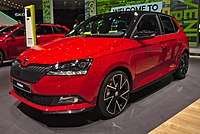
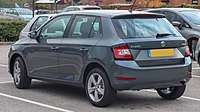
The third generation Fabia was introduced at the Paris Motor Show in October 2014, with sales starting in the following month. Production was launched prior to the end of August 2014 in Mladá Boleslav,[18] with manufacturing of the estate version first occurring in December 2014.[19] Due to the low sales of RS models from the previous model generation, a hot hatch variant is not planned for production.[20]
The Mk3 Fabia - like the facelifted Mk5 Volkswagen Polo starting 2014 - underwent a major technical revision, being based on the PQ26 platform: a mixture of the PQ25 platform (Volkswagen Polo MK5 pre-facelift, 2009-2014) and the MQB platform, which is currently used by seven Volkswagen Group models. The chassis has been modified to "revert back to the Fabia’s original, first-generation design" by becoming 90 mm wider and 30 mm lower, resulting in more interior and boot space. Despite being 8 mm shorter, the Mk3 Fabia still offers more passenger room due to its extended wheelbase. Simultaneously, its weight has been reduced by 65 kg (143 lb). A similar approach was applied to the styling, according to Škoda designer Marko Jevtic: "It [the Mk3 model] has the qualities of the first Fabia, [...] We wanted its simplicity; we did not want to overload the design."[21]
The Mk3 Fabia won the "Overall winner" and "Best small car" categories of the 2015 What Car? Car of the Year awards.[22]
Safety
The 3rd generation Fabia now comes equipped with the Front assist safety system. It gathers data from a radar sensor to automatically warn the driver and apply the brakes at the possibility of a collision at certain speeds.
Engines
The powertrain selection for the Mk3 Fabia was borrowed from the current Mk5 Polo, although the missing 1.2 litre 55 kW TDI engine will be included in the fuel economy-oriented Greenline model that will be released in late 2015. The 1.2 litre inline-three petrol engines from the Mk2 model were replaced by smaller but more efficient 1.0 litre engines.[24]
| Engine designation | Production | Engine code (family) | Displacement, configuration, valvetrain, fuel system, aspiration | Motive power at rpm | max. torque at rpm | Gearbox (type), drive | Top speed [km/h] | 0–100 km/h [s] (0–62 mph) | Combined consumption [l/100 km / mpg imp / mpg US] | CO2 [g/km] |
|---|---|---|---|---|---|---|---|---|---|---|
| 1.0 MPI | 10/2014– | CHYA | 999 cc (61.0 cu in) I3, 12V DOHC belt driven, manifold injection, natural aspiration | 60 PS (44 kW; 59 hp)@5000–6000 | 95 N⋅m (70 lb⋅ft)@3000–4300 | 5-speed manual, FWD | 160 km/h | 15,7 s | 4.7 l / 60 / 50 | 106 g/km |
| CHYB | 75 PS (55 kW; 74 hp)@6200 | 95 N⋅m (70 lb⋅ft)@3000–4300 | 172 km/h | 14,7 s | 4.8 l / 58.85 / 49 | 108 g/km | ||||
| 1.2 TSI | 10/2014–6/2017 | CJZC (EA211) | 1,197 cc (73.0 cu in), I4, 16V DOHC belt driven, direct injection, turbocharged | 90 PS (66 kW; 89 hp)@4400–5400 | 160 N⋅m (118 lb⋅ft)@1400–3500 | 5-speed manual, FWD | 182 km/h | 10,9 s | 4.7 l / 60 / 50 | 107 g/km |
| CJZD (EA211) | 110 PS (81 kW; 108 hp)@4600–5600 | 175 N⋅m (129 lb⋅ft)@1400–4000 | 6-speed manual, FWD | 196 km/h | 9,4 s | 4.8 l / 58.85 / 49 | 110 g/km | |||
| 7-speed automatic DSG, FWD | 196 km/h | 9,4 s | 4.7 l / 60 / 50 | 109 g/km | ||||||
| 1.0 TSI | 6/2017- | CHZB (EA211) | 999 cc (61.0 cu in), I3, 12V DOHC belt driven, direct injection, turbocharged | 95 PS (70 kW; 94 hp)@5000–5500 | 160 N⋅m (118 lb⋅ft)@1500–3500 | 5-speed manual, FWD | 183 km/h (Hatchback), 187 km/h (combi) | 10.6 s (Hatchback), 10.8 s (combi) | 4.3 l / 65.7 / 54.7 | 99 g/km |
| CHZC (EA211) | 110 PS (81 kW; 108 hp)@5000–5500 | 200 N⋅m (148 lb⋅ft)@2000–3500 | 6-speed manual, FWD | 196 km/h (Hatchback), 199 km/h (combi) | 9.5 s (Hatchback), 9.6 s (combi) | 4.4 l / 64.2 / 53.5 | 103 g/km | |||
| 7-speed automatic DSG, FWD | 9.8 s | 4.5 l / 62.8 / 52.3 | 106 g/km | |||||||
| Engine designation | Production | Engine code (family) | Displacement, configuration, valvetrain, fuel system, aspiration | Motive power at rpm | max. torque at rpm | Gearbox (type), drive | Top speed [km/h] | 0–100 km/h [s] (0–62 mph) | Combined consumption [l/100 km / mpg imp / mpg US] | CO2 [g/km] |
|---|---|---|---|---|---|---|---|---|---|---|
| 1.4 TDI | 2014– | CUSB | 1,422 cc (86.8 cu in), I3, 12V DOHC belt driven, common rail, turbocharged | 90 PS (66 kW; 89 hp)@3000–3250 | 230 N⋅m (170 lb⋅ft)@1750–2500 | 5-speed manual, FWD | 182 km/h | 11.1 s | 3.4 l / 83.1 / 69.2 | 88 g/km |
| 7-speed automatic DSG, FWD | 3.6 l / 78.5 / 65.3 | 94 g/km | ||||||||
| CUTA | 105 PS (77 kW; 104 hp)@3500–3750 | 250 N⋅m (184 lb⋅ft)@1750–2500 | 5-speed manual, FWD | 193 km/h | 10.1 s | 3.5 l / 80.71 / 67.2 | 90 g/km |
Motorsport
The Škoda Fabia R5 is a Group R rally version of the car and it has been competing in the European Rally Championship since the 2015 edition, as well as in the World Rally Championship-2, also since the 2015 edition.
Concept cars
The Funstar (stylised as FUNStar) is a pick-up concept car based on the Mk3 Fabia. It was designed by Škoda Auto University students as a throwback to the Felicia Fun, a compact pick-up car produced during the 1990s. It was shown at the annual 2015 Worthersee GTI fan meeting.
The exterior received a unique paint make-up, complemented with green day-running lights, 18-inch wheels from the Octavia RS and bonnet vents. The pick-up bed required the removal of the C-pillars, necessitating wider B-pillars and stiffened side panels to retain structural strength. The Funstar is powered by a 1,2 litre TSI petrol engine, paired with a 7-speed dual-clutch transmission. A 1,8 litre engine was originally planned for use but could not be implemented due to its size.[26]
References
- ↑ AutoCar (12 October 2004). "Czechaholic: Skoda Fabia RS Long Test". Archived from the original on 27 May 2007. Retrieved 2 March 2007.
- ↑ Auto Express (7 June 2005). "Skoda Fabia RS Long Term Test". Retrieved 4 March 2007.
- ↑ FastHatchbacks.com (1 March 2004). "Long Term Skoda Fabia RS". Retrieved 4 March 2007.
- ↑ Skoda.UK. "Fabia vRS Special Edition". Retrieved 27 July 2007.
- ↑ http://articles.economictimes.indiatimes.com/2013-05-18/news/39337198_1_skoda-auto-india-honda-cars-india-skoda-fabia
- ↑ Euro Auto Trends (12 December 2006). "Skoda to launch Fabia II". Retrieved 19 July 2007.
- ↑ "Seat boss: New Ibiza matches Toyota quality". Autonews.com. Retrieved 12 May 2008.
The Ibiza is the first small model to use VW group's PQ25 architecture, which later will underpin the VW Polo.
- ↑ "Next-generation VW small-car platform to offer all-wheel drive". Leftlanenews.com. Retrieved 6 May 2008.
- ↑ "Volkswagen Polo and Audi A1 will share new AWD platform". TopSpeed.com. Retrieved 5 June 2008.
- ↑ Auto Express (April 2007). "Skoda Fabia". Retrieved 25 July 2007.
- ↑ WhatCar? (17 July 2007). "First look at Skoda Fabia Estate". Retrieved 25 July 2007.
- ↑ Autoblog (18 July 2007). "Big Tease: Skoda releases teaser pic of Fabia Estate". Retrieved 25 July 2007.
- ↑ Škoda-Auto (14 August 2007). "The New Škoda Fabia Combi". Retrieved 14 August 2007.
- ↑ Škoda-Auto.com (16 July 2007). "New Škoda Fabia Combi". Retrieved 18 July 2007.
- ↑ Auto Express. "Auto Express Skoda Fabia 2010 Review". Retrieved 18 October 2011.
- ↑ The Inspiration Room Daily (27 May 2007). "Skoda Fabia Cake". Retrieved 26 July 2007.
- ↑ Euro NCAP. "Skoda Fabia". Retrieved 26 July 2007.
- ↑ "Production of new Škoda Fabia set for end of August". praguepost.com. 4 October 2014. Retrieved 1 June 2015.
- ↑ Mihnea Radu (15 December 2014). "2015 Skoda Fabia Estate / Combi Production Starts [Photo Gallery]". autoevolution. Retrieved 11 January 2015.
- ↑ James Taylor (27 October 2014). "No hot vRS version for new 2015 Skoda Fabia". Car Magazine. Retrieved 11 January 2015.
- ↑ Jonathan Burn (8 January 2015). "New Skoda Fabia specs and details". Auto Express. Retrieved 11 January 2015.
- ↑ Matthew Burrow (7 January 2015). "New Skoda Fabia specs and details". What Car?. Retrieved 11 January 2015.
- ↑ Euro NCAP. "Skoda Fabia". Retrieved 11 January 2015.
- ↑ Mihnea Radu (7 August 2014). "New Skoda Fabia Engines Revealed, Including 3-Cylinder 1.4 TDI". autoevolution. Retrieved 11 January 2015.
- ↑ Matt Burt (30 September 2014). "New estate-bodied Skoda Fabia Combi features a 530-litre boot". autocar.co.uk. Retrieved 1 June 2015.
- ↑ Graham Hope (28 April 2015). "Unique Skoda Fabia Funstar pick-up revealed". Auto Express. Retrieved 1 June 2015.
External links
| Wikimedia Commons has media related to Škoda Fabia. |
- "Škoda Fabia". – Škoda Auto Official Website
- "Škoda Fabia". – Škoda UK Website
| Type | 1990s | 2000s | 2010s | ||||||||||||||||||||||||||||||||||||
| 0 | 1 | 2 | 3 | 4 | 5 | 6 | 7 | 8 | 9 | 0 | 1 | 2 | 3 | 4 | 5 | 6 | 7 | 8 | 9 | 0 | 1 | 2 | 3 | 4 | 5 | 6 | 7 | 8 | |||||||||||
| City car | Citigo | ||||||||||||||||||||||||||||||||||||||
| Supermini | Favorit/Forman | ||||||||||||||||||||||||||||||||||||||
| Felicia | |||||||||||||||||||||||||||||||||||||||
| Fabia I | Fabia II | Fabia III | |||||||||||||||||||||||||||||||||||||
| Small family car | Rapid | ||||||||||||||||||||||||||||||||||||||
| Octavia I | Octavia II | Octavia III | |||||||||||||||||||||||||||||||||||||
| Large family car | Superb I | Superb II | Superb III | ||||||||||||||||||||||||||||||||||||
| LAV | Roomster/Praktik | ||||||||||||||||||||||||||||||||||||||
| Mini SUV | Yeti | ||||||||||||||||||||||||||||||||||||||
| Compact SUV | Karoq | ||||||||||||||||||||||||||||||||||||||
| SUV | Kodiaq | ||||||||||||||||||||||||||||||||||||||